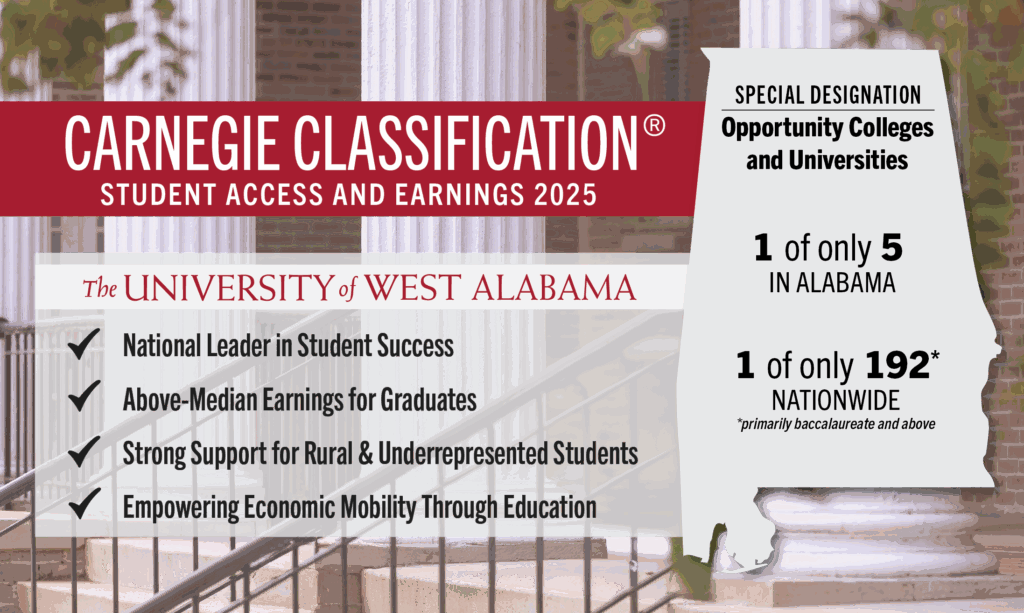
The University of West Alabama has earned national recognition from the Carnegie Classification of Institutions of Higher Education in its Student Access and Earnings Classification, underscoring the university’s commitment to advancing students’ economic mobility, employment opportunities, and long-term career success.
UWA is one of only five schools in Alabama to be designated Opportunity Colleges and Universities, holding the second-highest ratio of access to earnings, the highest of three ranked public institutions in Alabama. UWA is one of only 192 institutions nationwide offering primarily baccalaureate and above degrees to receive the designation.
Student Access and Earnings is the newest classification in the redesigned system of classifications from the American Council on Education and the Carnegie Foundation for the Advancement of Teaching.
This designation reflects UWA’s institutional focus on providing affordable, high-quality education that leads to meaningful employment and sustained earnings—especially for students from rural and underrepresented backgrounds. The Carnegie framework evaluates colleges and universities based on indicators including post-graduation outcomes, regional economic impact, and alignment with workforce needs.
“This is more than a mere classification—it’s validation of our mission,” said Todd G. Fritch, Ph.D., president of the University of West Alabama. “At UWA, we are committed to ensuring that our students don’t just earn degrees but that they launch careers that provide financial security and upward mobility.”
Fritch noted that the classification further emphasizes the impact that UWA has on its students by comparison of its placement in terms of both access and outcomes.
“UWA ranks in the top third for both underrepresented minority enrollment and Pell access for students entering the University,” he explained. “Upon graduation, they have above average economic returns, with our graduates enjoying above-median earnings. The strength of our post-graduation outcomes shows that our approach to the college experience helps propel students even further than if both access and earnings were only average.”
As a regional leader in education and workforce development, UWA offers a diverse portfolio of academic programs intentionally designed to prepare students for high-demand fields, including those with an emphasis on rural healthcare, education, and business.
UWA’s integration of career services, experiential learning, and employer partnerships ensures that students graduate with not only a credential, but also a competitive edge in the job market. The University has consistently expanded access to internships, licensure pathways, and professional certifications across disciplines.
“This designation in the Carnegie Classification system affirms that because of their experience at UWA, our students are achieving outcomes that can have a positive impact on their lives,” Fritch said. “Whether they’re becoming first-generation degree-earners, graduates returning to strengthen their communities, or maybe those looking to enter new, growing industries, our graduates leave UWA with the tools to thrive in a rapidly changing economy.”
UWA’s success in contributing to workforce readiness and economic development is especially impactful in Alabama’s Black Belt region. The university’s mission-driven approach continues to elevate rural communities through education, innovation, and leadership.
About the 2025 Student Access and Earnings Classification
The 2025 Student Access and Earnings Classification focuses on student success. The classification measures whether institutions are enrolling and creating opportunities for students in communities the institutions serve and whether students earn competitive wages after they attend.
The Student Access and Earnings Classification recognizes a wide variety of institutions of all sizes, locations, and types as drivers of opportunities for students. Only 479 schools of varying degree level offerings have been named Opportunity Colleges and Universities, a new designation that identifies institutions within the classification that can serve as a model for studying how campuses can foster student success.